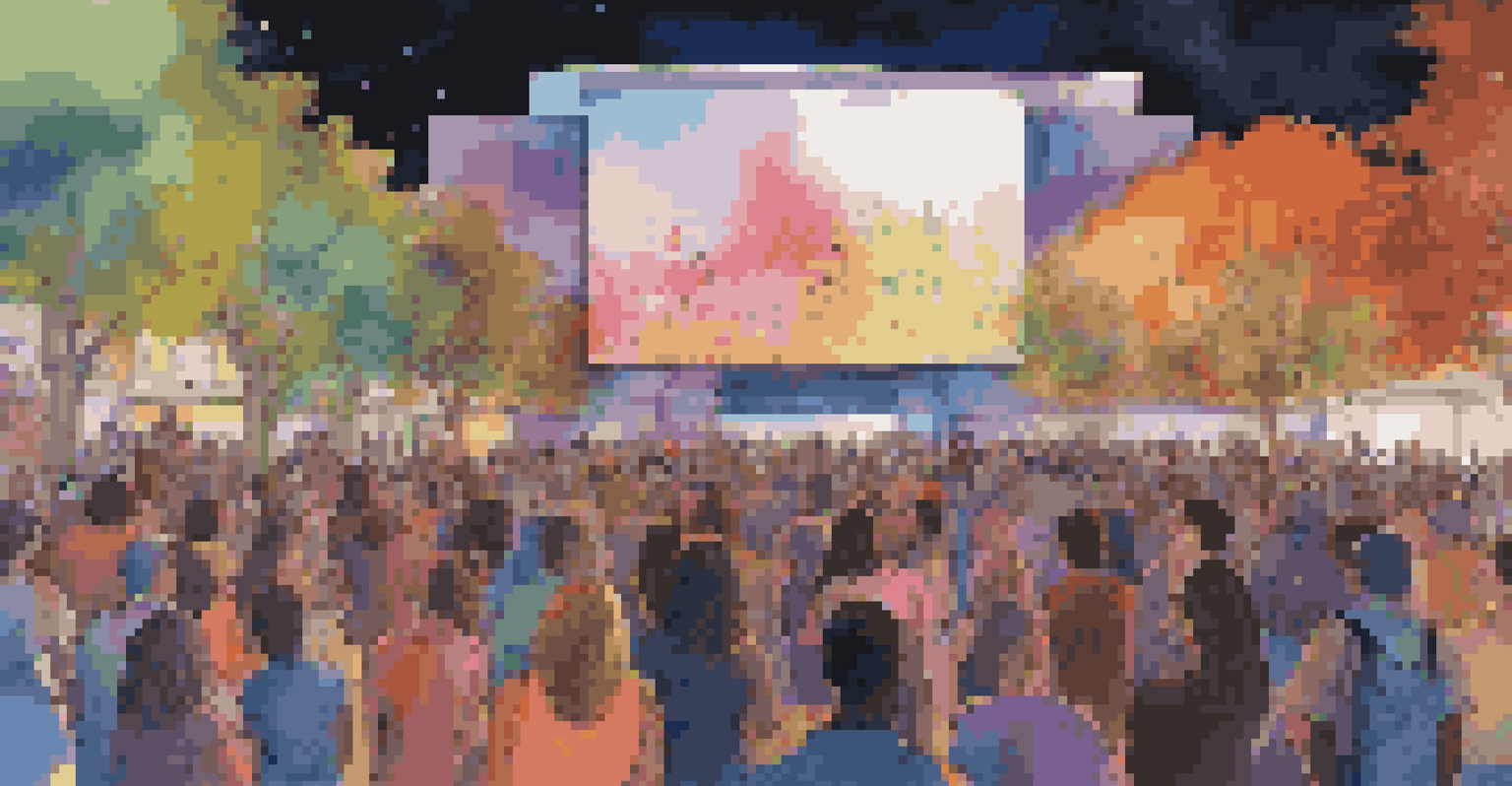The Role of Performance Art in Exploring Human Identity

What is Performance Art and Its Significance?
Performance art is a dynamic and expressive form of art that often combines visual art with live action. Unlike traditional forms of art, it emphasizes the artist's body and presence in a temporal space, allowing for a unique exploration of concepts such as identity, culture, and society. This medium can evoke emotions and provoke thoughts, making it a powerful tool for artists to communicate their inner experiences.
Art is not what you see, but what you make others see.
The significance of performance art lies in its ability to break boundaries and engage audiences in real-time. By inviting viewers to witness the unfolding of the artwork, artists create an intimate connection that can lead to deeper reflections on personal and collective identity. This immediacy can challenge preconceived notions and encourage viewers to consider their own identities in relation to the performance.
Moreover, performance art often incorporates elements from different disciplines, such as theater, dance, and visual art, creating a rich tapestry of expression. This blending not only enhances the narrative but also reflects the multifaceted nature of human identity. In this way, performance art serves as a mirror, allowing both artists and audiences to explore the complexities of who they are.
How Performance Art Challenges Conventional Identity Norms
Performance art often acts as a catalyst for questioning societal norms surrounding identity. By pushing the boundaries of gender, race, and cultural expectations, artists invite audiences to reconsider what identity means in a contemporary context. This disruption can lead to a broader understanding of the fluidity of identity, breaking away from rigid classifications.

For example, artists like Marina Abramović and Yoko Ono have used their performances to challenge traditional gender roles and societal expectations. Their works can provoke discomfort and curiosity, prompting viewers to reflect on their own biases and assumptions. In this way, performance art not only highlights the struggles of marginalized identities but also encourages dialogue about inclusivity and representation.
Performance Art's Unique Expression
Performance art combines live action and visual elements to explore complex themes of identity and society.
By presenting identity as a performance in itself, artists reveal the constructed nature of identity categories. This notion suggests that identity is not fixed but rather a continuous, evolving process shaped by personal experiences and societal influences. Such revelations can empower individuals to embrace their multifaceted selves and celebrate the complexities of human existence.
The Role of Cultural Context in Performance Art
Cultural context plays a vital role in shaping the themes and expressions found in performance art. Artists often draw from their cultural backgrounds to explore identity, using their work as a platform to share personal narratives that resonate with broader societal issues. This cultural lens adds depth to the performance, making it a rich source of insight into diverse human experiences.
The artist is a receptacle for the emotions that come from all over the place: from the sky, from the earth, from a scrap of paper, from a passing stranger, from a spider's web.
For instance, Indigenous performance artists utilize traditional storytelling methods to express their identity and connect with their heritage. Through the incorporation of rituals and cultural symbols, these performances not only honor their ancestors but also educate audiences about the ongoing impact of colonization and the importance of cultural preservation. This fosters a greater appreciation for cultural diversity and its influence on identity.
Moreover, the global exchange of ideas and artistic practices has led to a fusion of cultural perspectives in performance art. Artists from different backgrounds collaborate to create works that reflect both their individual experiences and shared human themes, transcending geographical boundaries. This cross-cultural dialogue enriches the artistic landscape and highlights the interconnectedness of human identity.
Emotional Expression and Vulnerability in Performance Art
One of the most compelling aspects of performance art is its ability to convey deep emotional truths. Artists often use their bodies, voices, and actions to express vulnerability, allowing audiences to witness raw, unfiltered experiences. This emotional authenticity can create a powerful bond between the performer and the audience, fostering empathy and connection.
For example, in her piece 'The Artist is Present,' Marina Abramović sat silently with visitors, inviting them to engage in a moment of shared presence. This simple act of being together in silence created a profound emotional exchange that transcended words. Such interactions highlight how performance art can serve as a space for healing and understanding within the realm of identity.
Challenging Identity Norms
By pushing societal boundaries, performance art invites audiences to reconsider and engage with the fluid nature of identity.
Furthermore, the exploration of trauma, loss, and resilience through performance art can resonate with viewers on a personal level. Artists often draw from their own life stories, using their performances as a means to process and communicate their experiences. This openness encourages audiences to confront their own emotions and reflect on their identities, ultimately promoting a sense of shared humanity.
The Impact of Technology on Performance Art
In today's digital age, technology has transformed the landscape of performance art, introducing new possibilities for expression and engagement. Artists are now able to incorporate multimedia elements, such as video projections and interactive installations, into their performances, enhancing the overall experience for audiences. This integration of technology allows for a more immersive exploration of identity.
Additionally, the rise of social media platforms has enabled artists to reach wider audiences and share their performances beyond the confines of traditional venues. Live-streaming and recorded performances can engage viewers from around the world, creating a sense of community among diverse audiences. This democratization of performance art fosters new conversations about identity that might not have been possible in a more localized setting.
However, the use of technology also raises questions about authenticity and the nature of the performance. As artists navigate the balance between live experience and digital representation, they challenge audiences to consider how technology shapes our understanding of identity. This ongoing dialogue invites critical reflections on the intersection of art, identity, and the digital realm.
The Future of Performance Art and Identity Exploration
As society continues to evolve, so too does the landscape of performance art. Future generations of artists are likely to explore even more complex themes surrounding identity, drawing from contemporary issues such as climate change, globalization, and social justice. This evolution presents an exciting opportunity for performance art to remain relevant and impactful in addressing the challenges of our time.
Emerging artists are increasingly utilizing collaborative practices, engaging with communities to co-create performances that reflect shared identities and experiences. This shift towards inclusivity not only enriches the art form but also empowers individuals to find their voices within the artistic narrative. Such collaborative efforts can foster a sense of belonging and encourage dialogue around social issues.
Technology's Role in Art
The integration of technology and social media has transformed performance art, expanding its reach and enhancing audience engagement.
Ultimately, the role of performance art in exploring human identity will continue to grow, serving as a vital platform for self-expression and societal reflection. As artists push boundaries and reimagine identity, audiences will be invited to embark on their own journeys of exploration, discovering the beauty and complexity of what it means to be human.
Conclusion: The Lasting Influence of Performance Art
In conclusion, performance art plays a crucial role in exploring human identity by challenging norms, evoking emotions, and fostering dialogue. Through its dynamic and immersive nature, this art form invites both artists and audiences to reflect on their own identities and the shared experiences that connect us all. As we move forward, the impact of performance art will only deepen, encouraging a greater understanding of the complexities of identity.
By embracing vulnerability and emotional expression, performance artists create spaces for healing and connection, ultimately promoting empathy among diverse audiences. The integration of technology and cultural context further enriches this exploration, allowing for a multifaceted understanding of identity that transcends geographical and societal boundaries.

As we continue to engage with performance art, we are reminded of its power to inspire change and provoke thought. The journey of exploring human identity through this vibrant medium is ongoing, inviting us all to participate in the conversation and celebrate the richness of our shared humanity.